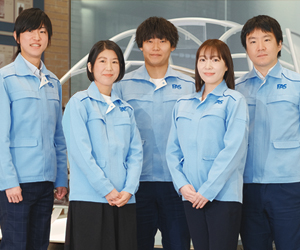In recent years the automotive industry has entered an era of great technological change, symbolized by such terms as “connected, autonomous, shared, electric” (CASE) and “mobility as a service” (MaaS). In addition to innovation in technology and changing market needs, today’s automobile industry is engaged in a fundamental shift, from vehicle ownership to vehicle sharing. In this new phase, automakers are challenged not just to manufacture vehicles but to create the customer experience itself.
Furukawa Automotive Systems Inc. (“
Name: Tomoyuki Yamai
Position: Managing Director and Operating Officer, Furukawa AS
Duties: Director in charge of quality and technology
table of contents
- CASE, MaaS and market needs in a changing business environment
- Sensing: Furukawa AS’ Domain of Activity in Automated Driving
- The pulsing method: A technology that draws a clear difference between Furukawa AS and its competitors in the field of sensing
- Why do the Alpha Terminal used in Furukawa AS wire harnesses deliver superior CASE performance?
- Furukawa AS and the Future That 5G Technology Will Bring
CASE, MaaS and market needs in a changing business environment
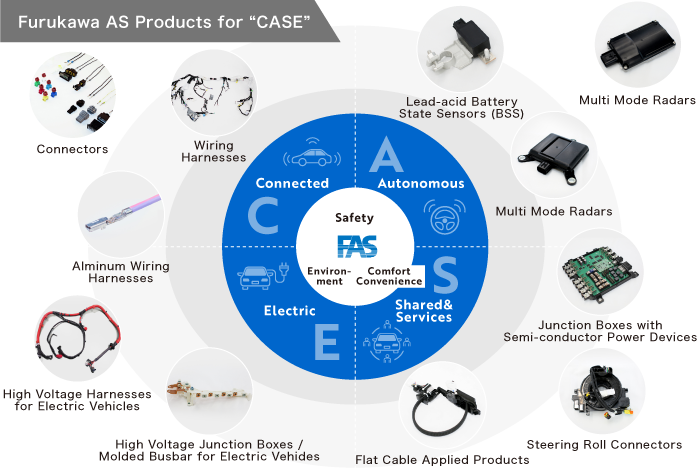
“In today’s automobile industry, the speed of technological innovation is accelerating as the competition for development intensifies. At the same time, the market is evolving on a two-track course, with consumers in the developed world focusing on comfort and premium features while growth elsewhere is driven by demand for automobiles as a basic means of transportation.”
“Next-generation technologies such as CASE and MaaS are gradually spreading into high-grade vehicles targeting developed-country markets and vehicles for special purposes. We expect them to spread into other markets as well. At this time, we’re focusing on the former, as we believe it will take time for these technologies to diffuse into those other markets. ”
“Starting with vehicle sharing, the automotive industry has been operating on the model of one family owning one vehicle, or one person owning one vehicle, to handle certain commuting and other daily-living needs as well as holiday and leisure uses. Rate of operation for a given vehicle in this scenario is in the single digits. As vehicle sharing grows year by year, we expect this figure to rise to 70–80%, as automobiles are used more intensively.”
“This rise in the rate of operation means that improved vehicle durability is a must. We have to make automobiles many orders more reliable and durable than they are even now.”
As vehicle sharing grows, so will the rate of operation of vehicles.
As the CASE and MaaS waves roll through the automotive industry, the functions of automobiles and people’s needs for them are changing. What is Furukawa AS’ role in this process?
Sensing: Furukawa AS’ Domain of Activity in Automated Driving
“Automated driving (the “A” in “CASE”) consists of three phases: Sensing, judgment and operation. The domain of activity in which Furukawa AS products operate is the first of these, sensing.”
“Sensing” refers to technologies that use sensors to measure a wide variety of information and express it numerically. It includes direct detection of phenomena outside the vehicle, such as things, the environment and external views, as well as detection of the environment inside the vehicle.
“Main products related to sensing include peripheral monitoring radar and lead-battery status sensors.”
“Also, automated driving will require 50% to 100% more electrical power and communications than current models to manage the entire series of actions that vehicles perform. Though they are hidden from sight, wire harnesses will contribute to the achievement and spread of automated driving, and we are working hard to advance them technologically.”
Furukawa AS develops numerous products that handle the core functions of automobiles.
We learned about wire harnesses in detail in the first Project Story.
“When manufacturing products, nothing is more important than reliability. That’s why we need technologies that can improve our existing products while creating new products that satisfy the necessary improvements for exceptional reliability and performance.”
Furukawa AS continually releases products of outstanding reliability. That commitment makes technological development a vital priority.
But what exactly are the sensing technologies that will make automated driving a reality?
In this section we dig deeper into the technical details of products that crystallize the wealth of technology Furukawa AS has cultivated.
The pulsing method: A technology that draws a clear difference between Furukawa AS and its competitors in the field of sensing
“Earlier I mentioned peripheral monitoring radar. These products sense the surrounding environment by directly sensing the positions and speeds of peripheral objects. The pulsing method is a unique approach that draws a clear line separating Furukawa AS from other companies. Our products using the pulsing method are distinctive for the density of resolution and distinguishing performance they achieve through the transmission, reception and conversion of signals. ”
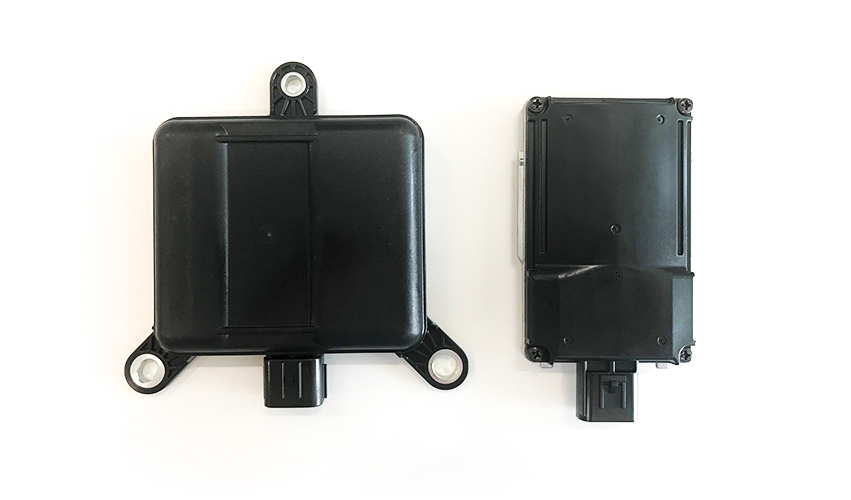
“In the sensing field, which provides indirect support for the emergence of automated driving, we supply lead-battery sensors. Our battery sensors also adopted pulsing method, a unique Furukawa AS approach that is not available from our competitors worldwide.”
You’ve mentioned that the pulsing method is a technology that sets Furukawa AS apart from the competition in the field of lead-battery status sensors. What exactly is the pulse method?
“In conventional sensing, electrical current and voltage passing in and out is measured to provide an estimate of the phenomenon we are interested in. In addition to these conventional features, Furukawa AS’ lead-battery status sensors themselves discharge electricity from the battery in pulses, actively measuring internal resistance in the battery to elicit the necessary information. This approach dramatically improves precision, providing measurements that were previously impossible, such as real-time battery-health status and starting capacity when the engine is stopped.”
And what about wire harnesses?
Why do the Alpha Terminal used in Furukawa AS wire harnesses deliver superior CASE performance?
“Wire harnesses are the trunk system that supports electronics in automobiles. With the rise of automated driving and the trend toward CASE, the number of electrical components and circuits is rising year by year. This trend creates strong demand for ever more lightweight design, without sacrificing operational performance and safety or compromising the overall design of each vehicle. Demand for aluminum wire harnesses is enormous, as they provide an effective means of reducing weight.”
One connection technology used in aluminum wire harnesses isthe Alpha Terminal.In our second interview(interview on Alpha Terminal),we received a detailed explanation of Alpha Terminal.
“This technology solves the difficulty of mounting aluminum wire harnesses in vehicles at a stroke. Our competitors are also working out various strategies for making wire harnesses out of aluminum, but Furukawa AS’ technology far surpasses all of them in the all-important task of achieving corrosion-resistant performance while holding costs in line. That’s why we can offer these products from a position of preeminence in the industry. ”
These products integrate technologies from across the Furukawa Electric Group. They enjoy a clear competitive advantage and are sure to contribute significantly to the emergence of a society in which automated driving is a daily reality.
Furukawa AS and the Future That 5G Technology Will Bring
“I think automated driving will spread in stages, beginning with specific markets and vehicle types and gradually diffusing from there.”
“Similarly, while there’s no question that 5G will bring benefits in the future, the topic of 5G leads to a discussion about society-wide infrastructure and the core technologies that come with it. Limiting our conversation to Furukawa AS’ products for the automotive sector, we don’t believe that the spread of 5G will cause us to change our product line all at once. Nonetheless, technological preparations for large-capacity, high-speed communications within vehicles are moving steadily forward.”
“We have already established a roadmap for the use of IoT, AI and so on to control Furukawa AS plants and manufacturing sites, and partial implementation has begun in accordance with that roadmap.”
We do not regard 5G as a technology that merely complements driving. We foresee an important role for it in production as well.
> Click here for Product Inquiries
In this article we’ve heard about CASE and Furukawa AS’ relationship with it.
The automobile industry is on the cusp of a major transition, with each company competing to develop the technologies of the next generation. The performance and features required will naturally evolve as market needs change.
As the pace of change accelerates, Furukawa AS can be expected to steadily ad significantly contribute to the achievement of automated driving, through the deployment of its unique technological strengths.
In our next installment, we will look at Furukawa AS’ involvement with the changing automotive industry from the standpoints of shared services (the “S” in “CASE”) and MaaS.
We will continue to update this series with fresh interviews as occasion demands.
Be sure to join us for the next Furukawa AS Project Story.
![[Vol.3] Project Story- Cars that change with CASE and MaaS, the future drawn by Furukawa AS (Part 1)-](https://furukawaas.xbiz.jp/wp-content/uploads/2020/06/5S7A2384-1024x683.jpg)
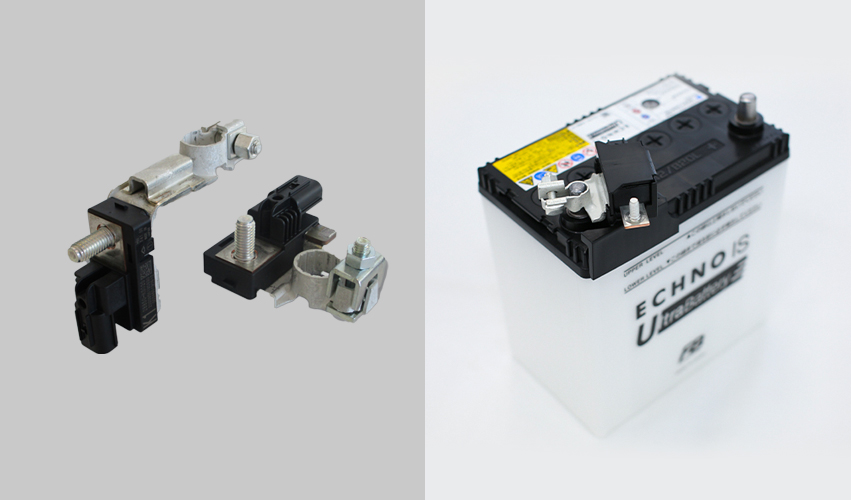
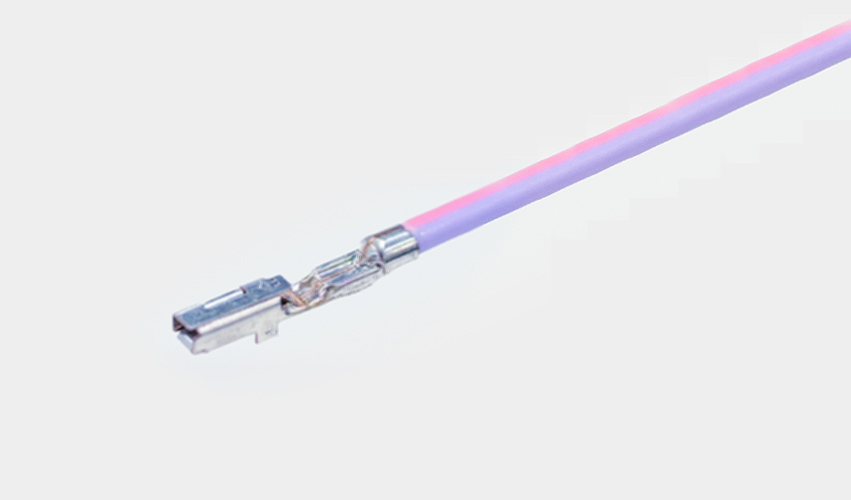
![[Vol.5] Project Story- Cars that change with CASE and MaaS, the future drawn by Furukawa AS (Part 3)-](https://furukawaas.xbiz.jp/wp-content/uploads/2020/08/re_5S7A2393-1024x683.jpg)
![[Vol.7] FAS in the World of Motorcycles (Part 2) (Interviews): Interviews with Developers](https://furukawaas.xbiz.jp/wp-content/uploads/2021/10/wire_image.jpg)
![[Vol.9] Welcome to the 9th FAS NEXT! The Co-creation of FAS Head Office and FAS Starts Here](https://furukawaas.xbiz.jp/wp-content/uploads/2022/03/IMG_0373-1024x683.jpg)
![[Vol. 7] FAS in the World of Motorcycles (Part 2): From Hidden Parts of Stock Motorcycles to MotoGP](https://furukawaas.xbiz.jp/wp-content/uploads/2021/08/56522010_m_3-1024x684.jpg)
